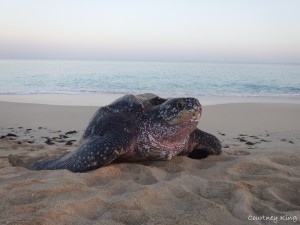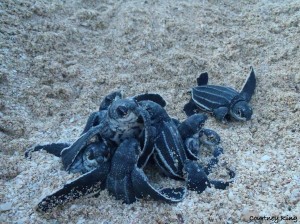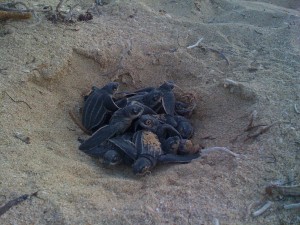
Summary of the 2014 Leatherback Nesting Season
As the 2015 leatherback season at Sandy Point rapidly approaches, we would like to share this summary of some of the key findings from last season.
2014 Leatherback Nesting Summary, Sandy Point, St. Croix.
In 2014, sea turtle biologists from Geographic Consulting saw a total of 84 individual nesting turtles throughout the four months of our night patrols. Fifty seven of these turtles nested at Sandy Point during previous seasons. This is the lowest number of nesting turtles in over 15 years, other than 2013, when we saw the same number of nesting leatherbacks. Further monitoring of the population will tell us whether this is a natural fluctuation in long term turtle nesting patterns or the decline of the Sandy Point nesting population. This trend illustrates why it is so important to continue to monitor leatherbacks at Sandy Point National Wildlife Refuge in St. Croix, US Virgin Islands each year.
In 2014, we welcomed 27 new leatherback turtles to the nesting population at Sandy Point. Of these, four were previously tagged at other nesting beaches: 2 were from the main island of Puerto Rico and one was from Vieques. Unfortunately, we have not yet been able to identify the origin of the tags on the fourth turtle. The remaining 23 turtles were neophytes, meaning that they have not been seen nesting before. With the addition of these 27 newly tagged leatherbacks in 2014, a total of 1,116 individuals have been tagged since the beginning of the project in 1981.
These 84 turtles laid a total of 356 nests at the refuge. On average, each turtle laid 3-4 nests over the course of the season, although we had one champion nester that laid a total of 9 nests in 2014! The number of nests that each leatherback lays during a season at Sandy Point has decreased over the last decade and is of some concern to turtle conservationists. This, combined with the lower number of nesting individuals, could result in a long term decline of this population.
The 2014 season was marked by an unusual pattern of beach erosion resulting in fewer relocated nests and abnormal distribution of nests throughout the refuge. In “normal” years we have to relocate one out of every three nests to prevent them from being washed away as the shoreline recedes throughout the season. This year, the shoreline was less dynamic and as a result we only relocated one out of every five nests. This was good news for the turtles because hatch success is usually about 10% higher in nests that are left in situ versus nests that have to be relocated. Dedicated relocation efforts of Geographic Consulting’s sea turtle team resulted in an estimated 1,968 hatchlings from nests that would have otherwise washed away, survived to emerge from their nests alive. They joined another 10,558 hatchlings from nests that were left in situ in emerging to hopefully produce a new generation of nesters at Sandy Point.





Comments
We look forward to helping with the educational sessions again this year. We would love to get your updates. Donna Boles shared this one with us.
OK. Sounds good. I will add your name to the list. I dont send these emails out very frequently, but the facebook updates will begin as soon as we get our full crew trained and patrolling. We should begin periodic updates around April 1. Thanks again and we will see you soon. Brian
Please keep me in the loop. I am very much interested in this program.
Comments, Questions? Contact Us.